Corcovado National Park
Osa Peninsula
The Osa Peninsula, located on the southwest coast of Costa Rica, is an ecological jewel and a must-see destination for all nature lovers. Known for its exceptional biodiversity, lush rainforests, pristine beaches and abundant wildlife, the Osa Peninsula is a must-see region of Costa Rica for lovers of unspoilt nature. It is home to the famous Corcovado National Park, often described as one of the most biodiverse places on the planet. It is also one of the largest primary forests on the Pacific coast of the American continent.
Geography
The Osa Peninsula is surrounded by the Pacific Ocean to the west and the Gulf of Dulce to the east. It covers some 1,700 km² and features a varied terrain including mountains, hills, coastal plains and mangroves. The region is criss-crossed by several rivers and streams that flow into the ocean, creating diverse habitats.
Climate: humid, you say?
The climate on the Osa peninsula is tropical, with high temperatures all year round and constant humidity. There are two main seasons:
- Dry season: December to April, characterized by sunny days and relatively low rainfall.
- Rainy season: May to November, with frequent and intense showers, especially in September and October.
Like another Costa Rican jewel, Tortuguero National Park, rainfall here is consistent.
Costa Rica’s most mythical park: Corcovado National Park
The park is renowned for its exceptional biodiversity. There are over 6,000 species of insects, 500 species of trees, 367 species of birds, 140 species of mammals, 117 species of amphibians and reptiles and 40 species of freshwater fish. Among the park’s most emblematic animals are the jaguar, tapir, macaw monkey and scarlet macaw.
How do I get to Corcovado National Park?
Planning to visit Corcovado National Park on the southern Osa Peninsula is an adventure in itself. You’ll need to plan well in advance to get there, as entry to the national park is limited.
Here are the main options for getting to Corcovado National Park, taking into account the various entry points and means of transport available.
All sectors at Corcovado Park
- La Leona (near Carate) – east coast of the Osa peninsula
- Los Patos (near La Palma) – east coast of the Osa peninsula
- El Tigre: (near La Palma) – east coast of the Osa peninsula
- San Pedrillo (accessible by boat from Drake Bay or Sierpe) – west coast of the Osa peninsula
- Sirena (accessible by boat from Drake Bay or from Sierpe) – west coast of the Osa peninsula
- Los Planes: (accessible by road from Drake Bay) – west coast of the Osa peninsula
Access by Plane
Flying is one of the fastest and most convenient ways to reach Corcovado Park. It’s a great time-saver, especially if you’re in Costa Rica for a short stay. Only one airline, Sansa, offers regular flights from or to San José to Bahia Drake or Puerto Jimenez.
- San José to Puerto Jiménez: Sansa offers daily flights from San José to Puerto Jiménez. The flight takes around 50 minutes.
- San José to Bahia Drake: flights are also available from San José to Drake Bay, offering another convenient option for reaching the Osa Peninsula.
Access by route
For those who prefer to travel by road, Corcovado can be reached by car, bus or boat.
By car
- To Puerto Jiménez: the access road to Puerto Jiménez is in excellent condition.
- From Puerto Jiménez to Carate: from Puerto Jiménez, you can continue by car to Carate, which is near the La Leona entrance to Corcovado Park. The road can be difficult, especially during the rainy season, and a 4×4 vehicle is essential.
- To Drake: for a long time, the road to Bahia Drake was a living hell. You had to cross many rivers, some of them quite deep. In recent years, a number of bridges have been built, and although the road is still dirt, it has improved considerably. It is now possible to reach Bahia Drake by car. However, this itinerary requires a 4×4 for greater comfort.
By bus
- San José to Puerto Jiménez: public buses depart daily from San José to Puerto Jiménez. The bus journey takes around 8-10 hours.
- Puerto Jiménez to Carate: from Puerto Jiménez, cabs or local buses can take you to Carate.
San José to Sierpe: from the capital, public buses will take you to Sierpe. From there, you’ll need to take a water cab to Drake. Allow a full day’s travel and don’t plan any excursions that day.
Access by boat
Access by boat is a practical and undoubtedly more atypical option, particularly for reaching the San Pedrillo and Sirena entrances.
Reach Bahia Drake by boat
- Sierpe to Drake Bay: from Sierpe, take a water cab through the mangroves and along the coast to Drake Bay. The journey takes approximately 1 to 1.5 hours. These water cabs will drop you off at your hotel or at Drake beach. You’ll then need a transfer to your hotel if it’s not accessible by boat.
- Drake Bay to San Pedrillo or Sirena: daily boat trips depart from Drake Bay to visit the park at San Pedrillo or Sirena.
- From Sierpe to San Pedrillo or La Sirena: if you’re short of time, you can take a day trip from Sierpe to either San Pedrillo or La Sirena. The journey will take longer: 1:30 for San Pedrillo / 2:00 for La Sirena.Rejoindre Puerto Jimenez en bateau
There is no regular boat service from the Pacific to Puerto Jimenez, which lies in the Golfo Dulce. However, we can arrange private boat transfers between La Sirena and Puerto Jimenez.
Getting to Corcovado Park from Puerto Jiménez / Carate
Access t Corcovado Park
It doesn’t happen overnight. First of all, you need a certified park guide.
No other guide is allowed to take you into the park.
You also need to have bought your entrance ticket, and places are limited.
In high season, many people end up with their beaks in the water.
Access to Corcovado from Puerto Jimenez
From Puerto Jimenez, you can visit either the Carate or Los Patos sectors. We generally recommend the more biologically intense Carate sector. Los Patos is nevertheless worth a visit, as here the primary forest is truly intact.
If you’re staying in Puerto Jimenez, many tour operators offer guided excursions to the Carate sector of the park.
If you’re staying further south, in Cabo Matapalo (recommended), it’s best to have your own vehicle. You’ll meet your guide in Carate, giving you greater freedom of movement on your return. Carate’s immense beach is a real paradise, and it would be a shame to just drive along it.
Access to Corcovado from Bahia Drake
Most tourists come to Bahia Drake not only to enjoy the resorts of San Pedrillo and La Sirena, but also to visit Isla del Caño, a small island with exceptional underwater fauna. This is the most visited area of the park.
If you’re staying in or near Bahia Drake, all hotels offer excursions to the national park or to Isla del Caño. This is why Bahia Drake is more popular with tourists than those on the other side of the Osa Peninsula.
From Los Patos to Carate via La Sirena – 3 days
If you’re looking for the ultimate in jungle immersion, we organize excursions through Corcovado Park and the Osa Peninsula to the various resorts. You’ll need to plan for 2 or 3 nights in the national park. You’ll have the opportunity to observe the wide variety of flora and fauna for which Osa and Costa Rica are famous.
The most intense: from Los Patos to La Sirena and back to Carate. This long loop will take you through all the different ecosystems of the Osa Peninsula. The Los Patos sector is the wildest of them all. It’s a superb experience, but a tough one, as the gradient, heat and walking times are not suitable for everyone. You’ll need to plan an overnight stay in the park at the Sirena ranger station.
The great classic: you set off from Carate to reach the Sirena or vice versa. Spend 1 or 2 nights at the ranger station, then head back either to Carate or Drake. We’ll take care of your luggage. This tour runs along the maritime side of Corcovado Park. There is little or no change in altitude. Only the heat can sometimes be uncomfortable, but there are many paths through the forest, and your guide will be able to point you in the right direction.
The least known and wildest: from Bahia Drake, you reach the San Pedrillo resort by land. A 17 km hike on the first day through virtually untouched rainforest. A night in the jungle is on the agenda, and the next day you’re off on a 10 km trek. Return to Bahia Drake at the end of the day.
This unique trek is guaranteed to be an extraordinary experience.
This adventure is reserved for good trekkers and those able to adapt to rustic comfort.
Corcovado Park from Bahia Drake – 1 day
If you’re staying at Bahia Drake, you can plan to visit three of the national park’s entrances.
Los planes: this area has the advantage of being flat. A 4.2 km trail is ideal for birdwatchers and those with limited walking ability. A more strenuous 18 km excursion takes you to the very edge of the park, where you’ll discover a splendid waterfall at the foot of which you can cool off.
This is the first access to Corcovado Park. Closed on public holidays.
San Pedrillo: visit the Llorona waterfall, which flows directly into the sea. This 18-kilometer excursion is perfect for adventurers at heart. More traditional excursions of 4 to 12 km are also available. A beautiful beach borders the resort, and the animal life is rich and varied.
Four species of monkey live in Corcovado Park, as do pumas, tapirs, coatis, anteaters, sloths and many other species. Entrance is limited to 150 people per day.
Most visitors reach the resort by boat.
La Sirena: with 20 km of trails, this is the most popular resort. The terrain here is flat and easy to access. The resort is the only one equipped for overnight stays. Lunch is compulsory at La Sirena. No food or plastic bottles are allowed inside. The biodiversity of La Sirena is astonishing, and it’s not uncommon to see four species of monkey, toucans, tapirs, pumas and, more rarely, a jaguar or puma.
Corcovado Park from Puerto Jimenez – 1 day
Carate sector: this entrance to Corcovado National Park is still wild and of impressive natural beauty. Access is complicated, so this part of Corcovado National Park is much less frequented. The trails are easy and suitable for all ages.
Here you can observe: several species of mammals, small squirrels, coatis, four types of monkeys, such as the howler monkey, squirrel monkey, capuchin monkey or spider monkey, and of course many types of birds. The tapir is often present in the area, and anteaters and sloths love it.
Los Patos sector: this is the second entrance from Puerto Jimenez. It is mostly frequented by challenge-seekers who wish to complete the Corcovado crossing through indigenous Guayami territory.
El Tigre sector: the latest addition to Corcovado National Park, this sector is accessible by car from Puerto Jimenez. 7.2 km of trail with a vertical drop of over 400 m makes it the most difficult access in the park. Only for good trekkers looking for a bit of a challenge.
Reserving, a guarantee of your place
Reserve appetizers in advance
Booking is advisable, especially in high season. Entrance to the park is limited for each sector and, from December to March, many dates are frequently fully booked. If you want to spend the night at La Sirena, space is even more limited. Don’t venture to Bahia Drake or Puerto Jimenez unannounced, thinking you’ll be going to La Fleur au fusil the next day. In high season, hotels are often fully booked, and you may not be able to visit Corcovado Park.
Mandatory guide
A visit to Corcovado Park is only possible when accompanied by a national park guide. Even if you travel with a guide during your trip to Costa Rica, you will need to take on the additional services of a park guide. This measure, which some consider unfair, is linked to tourists’ lack of respect and negligence. This obligation is fairly recent, but the behavior and risks taken by some visitors have necessitated protective measures.
However, there is a significant advantage to this, as the local guide will take you where he knows there is a good chance of seeing this or that animal, he will know how to track footprints and will teach you to use all your senses.
Corcovado’s emblematic animals
Visitors flocking to Corcovado are mainly attracted by the wildlife. We recommend that you leave your expectations at home and let yourself be surprised by the daily discoveries. Coming to Corcovado to “see” a jaguar is not a good idea, and you’re likely to be disappointed. On the other hand, if you visit Corcovado and spot a Jaguaraundi (black panther) or a Puma, your happiness will be total.
Nevertheless, here is a non-exhaustive list of the animals that are easiest to spot in the national park.
Baird’s tapir
This large herbivorous land mammal is the largest mammal in Central America. They inhabit tropical rainforests, secondary forests, swampy areas and riverbanks. Corcovado National Park, with its diversity of ecosystems, offers an ideal habitat for these animals.
Costa Rica can boast an increasing tapir population, while the rest of the world is in constant decline. Corcovado National Park has become the best place in the world to observe them.
Adult tapirs can measure up to 2 meters in length and weigh between 250 and 300 kg.
Viewing areas: San Pedrillo station / La Sirena station / Carate station
Scarlet Macaw or Ara Macaw
This large red and blue parrot is a marvel of nature and one of the most emblematic birds of the Osa Peninsula.
This canopy-dwelling bird is one of nature’s most harmonious spectacles. From the terrace of your lodge, it’s not unusual to see them flying close by, or to hear their shrill calls from afar.
They often live in pairs or small family groups.
The Ara Macao population, which was long endangered according to the IUCN, has now been rescued thanks in particular to conservation and reforestation efforts around Corcovado National Park.
Observation areas: Carate station / Los Patos station / La Sirena station
The puma
This is the easiest feline to spot in Corcovado Park, even if it’s never guaranteed. It’s a powerful, agile feline, easily recognizable.
Males can reach 2.4 meters in length, including the tail, and weigh up to 100 kg. Females are generally smaller, weighing between 30 and 60 kg. Their coats are uniform in color, varying from light fawn to reddish brown. Young pumas have spots that disappear with age.
Pumas are opportunistic carnivores, hunting mainly mammals such as deer, monkeys and sometimes smaller animals. They are most active at dawn and dusk.
Viewing areas: Carate station / San Pedrillo station
Monkeys
The Osa Peninsula and Corcovado National Park are home to Costa Rica’s four species of monkey.
Capuchin monkeys (Cebus capucinus): known for their remarkable intelligence and expressive faces. They live in groups of 10 to 30 individuals. They can use stones to crack nuts, leaves as sponges to soak up water and sticks to extract insects from their hiding places. They have a keen sense of observation and imitation.
The mantled howler monkey Alouatta palliata and the black howler monkey Alouatta pigra: known for their powerful, distinctive growls, they are one of the most emblematic primates of Costa Rica’s tropical forests. The howler’s call, which can be heard up to three kilometers away, is used to mark their territory.
Males are larger than females, measuring between 40 and 70 cm in length, excluding the tail, and weighing between 6 and 9 kg. Females are slightly smaller, weighing between 4 and 6 kg.
They live in groups of 10 to 20 individuals.
The spider monkey (Ateles geoffroyi): one of the most agile and intriguing primates of the rainforests. Also known as the atel monkey.
Males and females measure between 30 and 60 cm in length, excluding the tail, and weigh between 6 and 9 kg.
Their prehensile tail, which can reach up to 90 cm, is robust and flexible, functioning as a fifth limb to grip branches and move around with agility.
Squirrel monkey: The squirrel monkey, also known as the titi, is a small primate native to Central America. It is one of the world’s smallest monkeys, measuring around 20 to 35 cm in length and weighing between 0.5 and 1.5 kg.
They live in groups of 5 to 30 individuals. They are known for their playful, inquisitive behavior.
Sightings: Costa Rica’s four species of monkey are particularly fond of the entire Osa Peninsula. They are ubiquitous throughout the area and beyond.
Sea turtles
Corcovado National Park is home to five species of turtle.
The green turtle – (Chelonia mydas) is the largest of the Chelonia family, growing to 1.5 meters in length and weighing between 80 and 130 kg. It feeds mainly on seaweed.
The hawksbill turtle (Eretmochelys imbricata) is known for its scale-patterned shell, once used to make combs and jewelry. It is threatened with extinction due to illegal trade in its shell. Conservation efforts in Costa Rica, and particularly in Corcovado National Park, offer hope that this concern will be reduced from high to medium.
The olive ridley turtle (Lepidochelys olivacea) is the smallest of the sea turtles, growing up to 1 meter long. It feeds mainly on sea grasses and jellyfish.
The leatherback turtle (Dermochelys coriacea) is the world’s largest turtle, reaching lengths of up to 3 meters. It is a carnivore, feeding on fish, squid and crustaceans. It is in danger of extinction.
The loggerhead sea turtle (Caretta caretta) is also present in the park, but is less common than the other four species. It feeds mainly on crabs, mollusks and fish.
Where to sleep in Bahia Drake
Once you’ve arrived in Bahia Drake, a wide choice of hotels is available. From small cabinas in the village to luxury hotels by the sea, everything is possible. Many accommodations offer all-inclusive packages with transfers from Sierpe or the airport, meals and excursions to the national park.
As an agency, we like to suggest beachfront hotels or those with beautiful views.
Some accommodations are only accessible by boat and are far from the village. That said, the village of Drake is of little interest.
Where to sleep in Puerto Jimenez
The small town of Puerto Jimenez offers mainly cabinas, lodges, hotels and rustic accommodation.
If you’re looking for more comfort, head further south between Cabo Matapalo and Carate. There’s more to choose from, and the countryside is more pleasant and unspoilt.
Some of the most luxurious lodges are ranked among the most beautiful in the world. Lapa Rios and Remanso top the list.
Some lodges on the beach offer the chance to sleep in tents, with the sea as a lullaby and nature omnipresent. A change of scenery guaranteed.
Other activities in Bahia Drake
Corcovado Park is usually visited early in the morning. By 13:00 you’ll be back at your hotel. Here are a few ideas to round off your day in style.
- Diving or snorkeling at Isla del Caño: this small island off Bahia Drake is a veritable aquarium. Rays, turtles, reef sharks, moray eels, seahorses and multicolored fish are right at home here.
- A night tour: Bahia Drake is one of the places in Costa Rica where a night tour is a must. It’s just incredible!!! You’ll be able to observe the area’s rich fauna with different eyes. Species such as snakes, tarantulas, frogs and bats populate the forest and are easier to observe at night than during the day.
- A kayak tour: Bahia Drake’s coastline lends itself well to sea kayaking. Some hotels make them available to their guests. Paddle along the mouths and you may just spot stingrays, crocodiles and barracudas.
Other activities in Puerto Jimenez / Cabo matapalo
- A kayak tour: the Golfo dulce is the world’s only tropical fjord and home to an astonishing variety of ecosystems. The mangrove swamps of Puerto Jimenez and the northern part of the gulf allow you to observe crabs, monkeys, crocodiles and other animals living on the shores.
- Night tour and bioluminescence: if you’re a week before or a week after the new moon, a night tour combined with a bioluminescence tour will leave you speechless. This experience is all the more enjoyable and beautiful in a kayak.
- In the footsteps of the gold diggers: the Osa Peninsula has long been the scene of the gold diggers. The area’s rivers carry a lot of sediment, and it’s still possible to find a few nuggets. This activity is supervised by a certified guide and allows you to put yourself in the shoes of a gold digger for a few hours.
- Waterfall rappelling: the Osa Peninsula and the Cabo Matapalo area are full of waterfalls. Experienced guides will lead you through the forest to some of them, where you can abseil down before enjoying a refreshing swim.
- Climbing a giant tree: at Cabo Matapalo, you can harness yourself to climb to the top of a tree over 60 m high. This experience will appeal to the most adventurous among you.

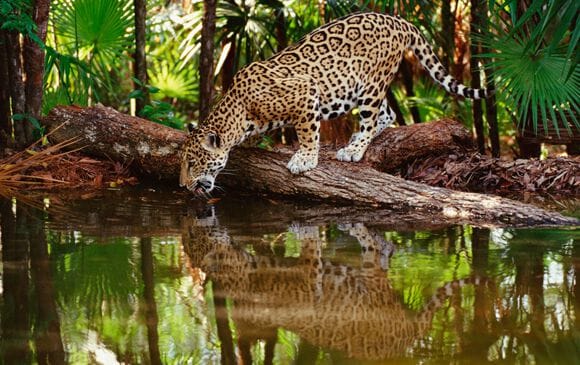
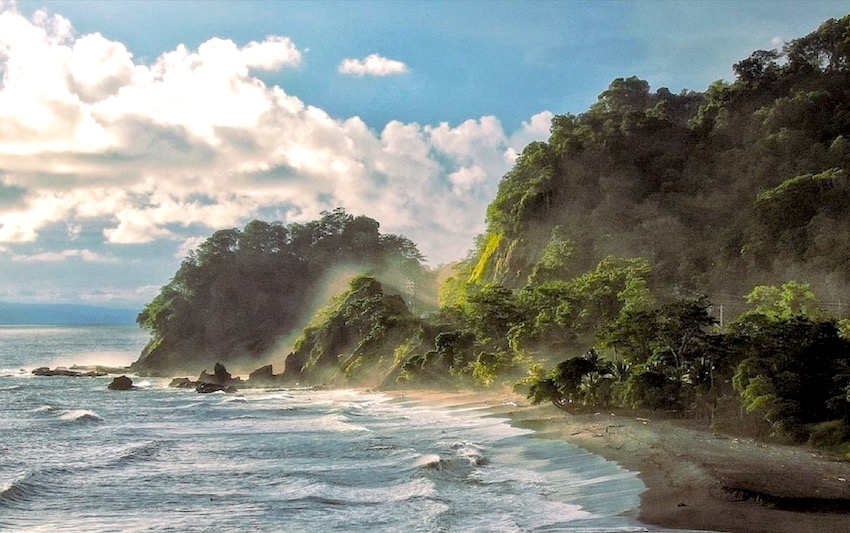

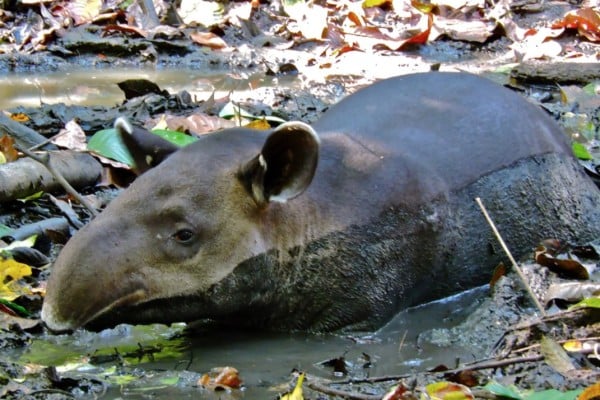
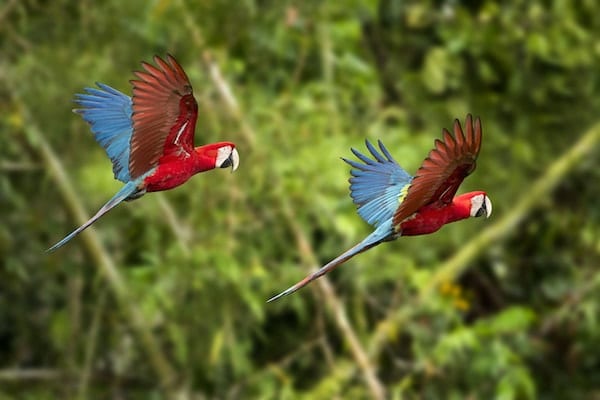

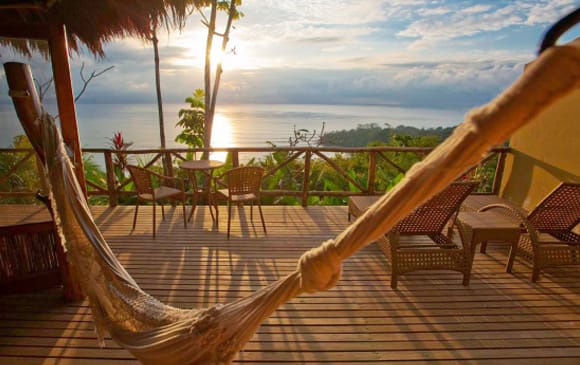

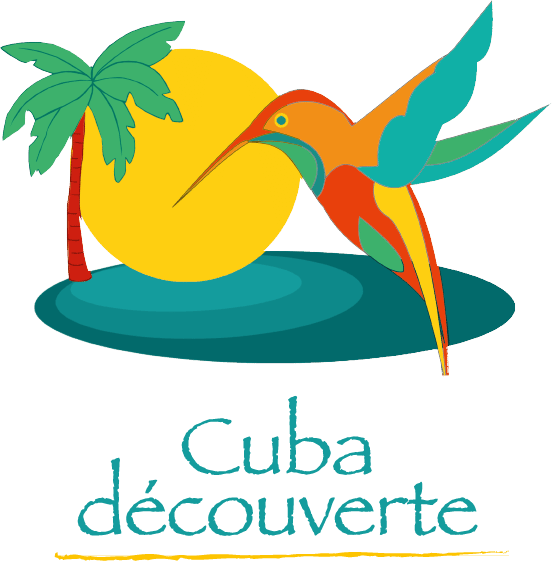
No comment regarding « Corcovado National Park »